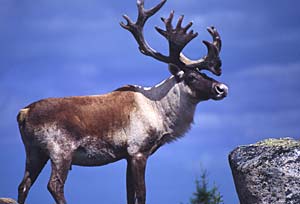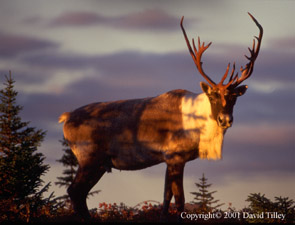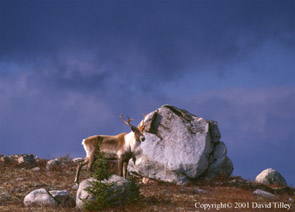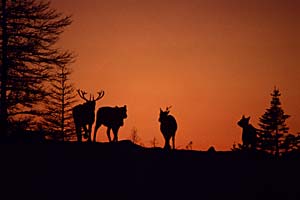Where the Caribou Roam (Home on the Barrens)
Reprinted from "The Nfld Sportsman" (Sept.-Oct.98) (Copyright © 1998 David Tilley)
 As Nflders we are truly privileged to hold the distinction of being wardens to the greatest herd of woodland caribou in the world. While many other popular game species, the moose for one, have had to be introduced, the caribou is a true native that has thrived here since the beginning. Apart from the famous George River herd in Labrador their are several small but healthy herds on the island. A total of 27 separate populations have been monitored, from the Hampden herd of 1,500 which is stationary throughout the year to the Buchans Plateau herd of 7,500 that makes the long migration annually to winter along the south maritime barrens where snow cover is sparse. Our vast reaches of bog and barren, safe as yet from the excesses of human development are ancestral home to these herds.
As Nflders we are truly privileged to hold the distinction of being wardens to the greatest herd of woodland caribou in the world. While many other popular game species, the moose for one, have had to be introduced, the caribou is a true native that has thrived here since the beginning. Apart from the famous George River herd in Labrador their are several small but healthy herds on the island. A total of 27 separate populations have been monitored, from the Hampden herd of 1,500 which is stationary throughout the year to the Buchans Plateau herd of 7,500 that makes the long migration annually to winter along the south maritime barrens where snow cover is sparse. Our vast reaches of bog and barren, safe as yet from the excesses of human development are ancestral home to these herds.
There is perhaps more known about this most important of wildlife resources then any other. A great deal of time and effort as been invested by our government scientists who with a minimum of resources have conducted ground breaking research to understand the migratory patterns and future viability of these herds. If the environmental assessment process as done nothing to ease pressure on other wildlife, it as contributed further resources to add to the database of accumulated knowledge for caribou. You do not have to travel the breadth of the country to see a less fortunate outcome, as the rest of Atlantic Canada stands in stark contrast with its populations long since decimated by overcrowding settlement.
 The extermination of wolves in the 1920s eliminated the need for migration for some herds. Choosing instead to calve on forested wintering grounds instead of the high open country, where wolves could not den in the rocky ground. As clear cutting continues on a greater scale and prey predator relations change, there may be further adaptions. The coyote as yet to make its presence felt, but will no doubt become a determining factor in future. A 1980s study of the middle ridge herd found that animals adjacent to logging operations tended to move away, adapting to avoid open areas. It follows that this increased dependence on timber stands in a continuing state of decline would affect the viability of the herd in the long run. The Bay De Nord wilderness reserve may prove to be a godsend to these animals.
The extermination of wolves in the 1920s eliminated the need for migration for some herds. Choosing instead to calve on forested wintering grounds instead of the high open country, where wolves could not den in the rocky ground. As clear cutting continues on a greater scale and prey predator relations change, there may be further adaptions. The coyote as yet to make its presence felt, but will no doubt become a determining factor in future. A 1980s study of the middle ridge herd found that animals adjacent to logging operations tended to move away, adapting to avoid open areas. It follows that this increased dependence on timber stands in a continuing state of decline would affect the viability of the herd in the long run. The Bay De Nord wilderness reserve may prove to be a godsend to these animals.
The milder winters of recent years have bolstered the strength of the herds, as wind protected valleys have been left bare to uncover a diversity of shrubs and plants in addition to the winter staple of tree lichen. Most of the scrub timbers that edge the barren lands are beyond the ambitions of the paper companies and the animals can use this cover to feed in relative safety when the snow deepens and chilling winds howl off the high open country.
My own knowledge of Caribou is limited to the small herds that occupy the Baie Verte Peninsula and Topsail areas. For many years I have hiked along deer trails, preferring the open landscape to the congestions of spruce thickets that slow progress through the otherwise open woods. The only true escape from the noise of machinery and the absence of wild abundance is the remoteness of the barrens. A trip cross country is never without frequent encounters with the ever roaming deer, who for a photographer offer a reliable subject in the absence of other prey. There are many creatures common to the barrens but the eternal presence of the herd keeps me busy when the hunting is poor. The crimson red goowitty that lines the open ridges in the fall make an excellent backdrop to the massive bucks with their sprawling antlers as they make their way down into the valleys to rut. As the harems grow in size they will begin to feed for extended periods in their favourite areas. The baffling winds and weather deciding the strategy on any given day.

In mid October at the peak of the rut it is likely that a determined buck will stalk a hiker in a steady deliberate charge to bring home the message of who really owns these barrens. This Jekyll and Hyde character trait is due to the production of powerful hormones that render the meat poison and the usually gentle disposition, fearsome.
Late fall is the time to take advantage of the prime feeding areas and shelter before moving on to higher ground where snow cover is kept down by frequent winds and the wooded hills offer escape to sheltered timber stands. Young Bucks spar playfully as the antlers are shed like trophies scattered on an ancient battleground. The bloody encounters with competing bucks have ended and the victorious older animals are charged with the responsibility of leading the herd into the early winter.
As the ponds freeze up the deer are drawn like magnets to wander around with relative ease, their parting hooves distributing the weight to negotiate ice to thin for a human. Much of the time is spent licking the semi-frozen slush as the burden of constant hoofing through mud soaked bog is lifted. Any relief from hardships is welcome since caribou endure plagues of flies and parasites in their constant wanderings as the search for food continues. A demanding task for an animal that must consume 15 lbs of dry herbs a day to maintain its body weight.
 Caribou on the Baie Verte Peninsula have increased in numbers in recent years with claims that the Northern peninsula herd has been coming down from the long range mountains to winter here as well as along the west coast delta. Wether this is due to a natural cyclic change or some man made intervention is unproven. It is definitely a boon to hunters in the area, as this past fall saw the first ever designation of the Peninsula as a Caribou management area.
Caribou on the Baie Verte Peninsula have increased in numbers in recent years with claims that the Northern peninsula herd has been coming down from the long range mountains to winter here as well as along the west coast delta. Wether this is due to a natural cyclic change or some man made intervention is unproven. It is definitely a boon to hunters in the area, as this past fall saw the first ever designation of the Peninsula as a Caribou management area.
The continued success of the island population will stand as testament to our resolve, as external forces assault our shores and uproot our people. The woodland caribou is our most valued wilderness asset and should continue to thrive, if the drive for economic development continues to be taken with their best interest in mind.
